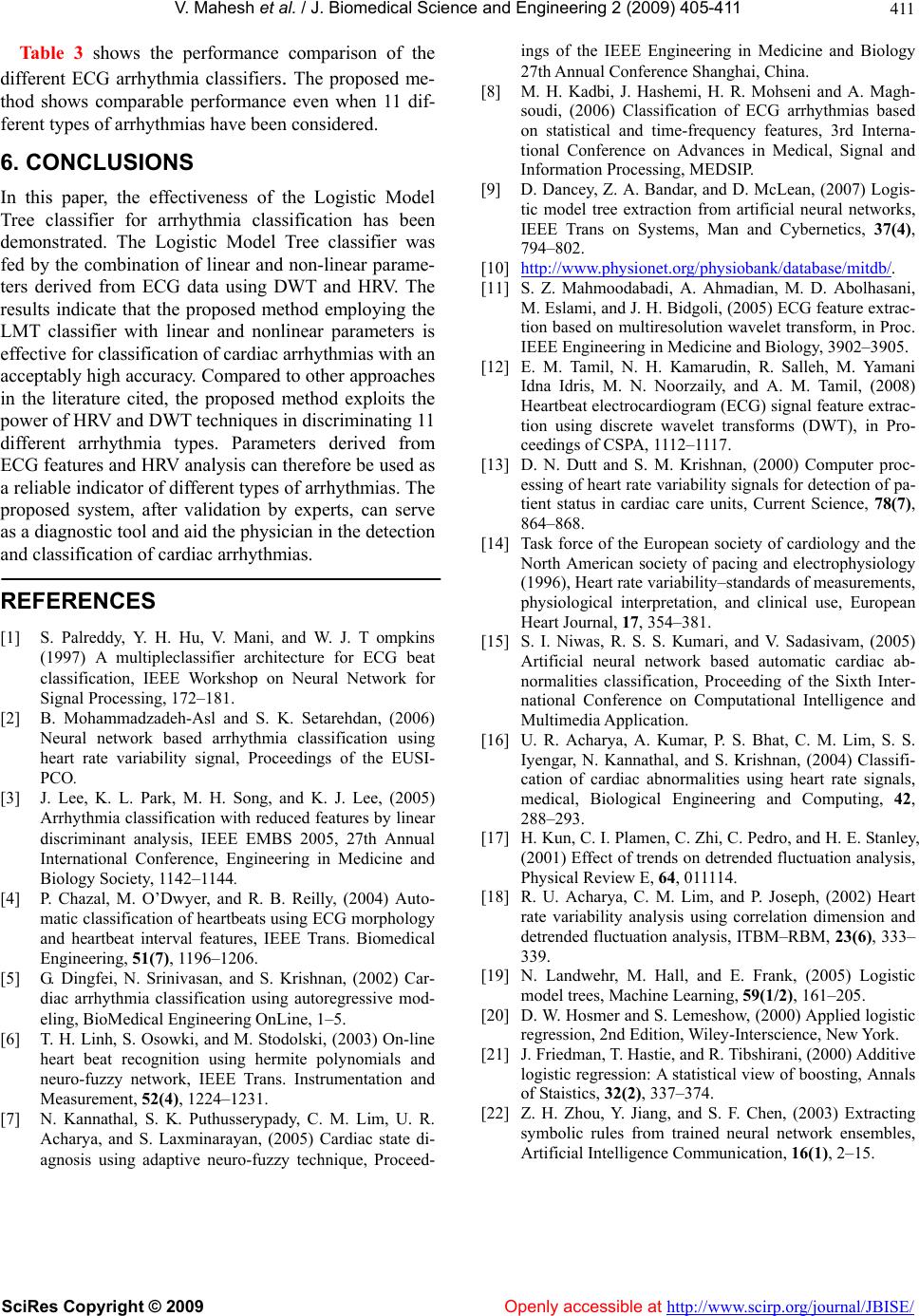
V. Mahesh et al. / J. Biomedical Science and Engineering 2 (2009) 405-411
SciRes Copyright © 2009 Openly accessible at http://www.scirp.org/journal/JBISE/
411
Table 3 shows the performance comparison of the
different ECG arrhythmia classifiers. The proposed me-
thod shows comparable performance even when 11 dif-
ferent types of arrhythmias have been considered.
6. CONCLUSIONS
In this paper, the effectiveness of the Logistic Model
Tree classifier for arrhythmia classification has been
demonstrated. The Logistic Model Tree classifier was
fed by the combination of linear and non-linear parame-
ters derived from ECG data using DWT and HRV. The
results indicate that the proposed method employing the
LMT classifier with linear and nonlinear parameters is
effective for classification of cardiac arrhythmias with an
acceptably high accuracy. Compared to other approaches
in the literature cited, the proposed method exploits the
power of HRV and DWT techniques in discriminating 11
different arrhythmia types. Parameters derived from
ECG features and HRV analysis can therefore be used as
a reliable indicator of different types of arrhythmias. The
proposed system, after validation by experts, can serve
as a diagnostic tool and aid the physician in the detection
and classification of cardiac arrhythmias.
REFERENCES
[1] S. Palreddy, Y. H. Hu, V. Mani, and W. J. T ompkins
(1997) A multipleclassifier architecture for ECG beat
classification, IEEE Workshop on Neural Network for
Signal Processing, 172–181.
[2] B. Mohammadzadeh-Asl and S. K. Setarehdan, (2006)
Neural network based arrhythmia classification using
heart rate variability signal, Proceedings of the EUSI-
PCO.
[3] J. Lee, K. L. Park, M. H. Song, and K. J. Lee, (2005)
Arrhythmia classification with reduced features by linear
discriminant analysis, IEEE EMBS 2005, 27th Annual
International Conference, Engineering in Medicine and
Biology Society, 1142–1144.
[4] P. Chazal, M. O’Dwyer, and R. B. Reilly, (2004) Auto-
matic classification of heartbeats using ECG morphology
and heartbeat interval features, IEEE Trans. Biomedical
Engineering, 51(7), 1196–1206.
[5] G. Dingfei, N. Srinivasan, and S. Krishnan, (2002) Car-
diac arrhythmia classification using autoregressive mod-
eling, BioMedic a l E n g i n e e r i n g OnLine, 1–5.
[6] T. H. Linh, S. Osowki, and M. Stodolski, (2003) On-line
heart beat recognition using hermite polynomials and
neuro-fuzzy network, IEEE Trans. Instrumentation and
Measurement, 52(4), 1224–1231.
[7] N. Kannathal, S. K. Puthusserypady, C. M. Lim, U. R.
Acharya, and S. Laxminarayan, (2005) Cardiac state di-
agnosis using adaptive neuro-fuzzy technique, Proceed-
ings of the IEEE Engineering in Medicine and Biology
27th Annual Conference Shanghai, China.
[8] M. H. Kadbi, J. Hashemi, H. R. Mohseni and A. Magh-
soudi, (2006) Classification of ECG arrhythmias based
on statistical and time-frequency features, 3rd Interna-
tional Conference on Advances in Medical, Signal and
Information Processing, MEDSIP.
[9] D. Dancey, Z. A. Bandar, and D. McLean, (2007) Logis-
tic model tree extraction from artificial neural networks,
IEEE Trans on Systems, Man and Cybernetics, 37(4),
794–802.
[10] http://www.physionet.org/physiobank/database/mitdb/.
[11] S. Z. Mahmoodabadi, A. Ahmadian, M. D. Abolhasani,
M. Eslami, and J. H. Bidgoli, (2005) ECG feature extrac-
tion based on multiresolution wavelet transform, in Proc.
IEEE Engineering in Medicine and Biology, 3902–3905.
[12] E. M. Tamil, N. H. Kamarudin, R. Salleh, M. Yamani
Idna Idris, M. N. Noorzaily, and A. M. Tamil, (2008)
Heartbeat electrocardiogram (ECG) signal feature extrac-
tion using discrete wavelet transforms (DWT), in Pro-
ceedings of CSPA, 1112–1117.
[13] D. N. Dutt and S. M. Krishnan, (2000) Computer proc-
essing of heart rate variability signals for detection of pa-
tient status in cardiac care units, Current Science, 78(7),
864–868.
[14] Task force of the European society of cardiology and the
North American society of pacing and electrophysiology
(1996), Heart rate variability–standards of measurements,
physiological interpretation, and clinical use, European
Heart Journal, 17, 354–381.
[15] S. I. Niwas, R. S. S. Kumari, and V. Sadasivam, (2005)
Artificial neural network based automatic cardiac ab-
normalities classification, Proceeding of the Sixth Inter-
national Conference on Computational Intelligence and
Multimedia App lication.
[16] U. R. Acharya, A. Kumar, P. S. Bhat, C. M. Lim, S. S.
Iyengar, N. Kannathal, and S. Krishnan, (2004) Classifi-
cation of cardiac abnormalities using heart rate signals,
medical, Biological Engineering and Computing, 42,
288–293.
[17] H. Kun, C. I. Plamen, C. Zhi, C. Pedro, and H. E. Stanley,
(2001) Effect of trends on detrended fluctuation analysis,
Physical Review E, 64, 011114.
[18] R. U. Acharya, C. M. Lim, and P. Joseph, (2002) Heart
rate variability analysis using correlation dimension and
detrended fluctuation analysis, ITBM–RBM, 23(6), 333–
339.
[19] N. Landwehr, M. Hall, and E. Frank, (2005) Logistic
model trees, Machine Learning, 59(1/2), 161–205.
[20] D. W. Hosmer and S. Lemeshow, (2000) Applied logistic
regression, 2nd Edition, Wiley-Interscience, New York.
[21] J. Friedman, T. Hastie, and R. Tibshirani, (2000) Additive
logistic regression: A statistical view of boosting, Annals
of Staistics, 32(2), 337–374.
[22] Z. H. Zhou, Y. Jiang, and S. F. Chen, (2003) Extracting
symbolic rules from trained neural network ensembles,
Artificial Intelligence Communication, 16(1), 2–15.